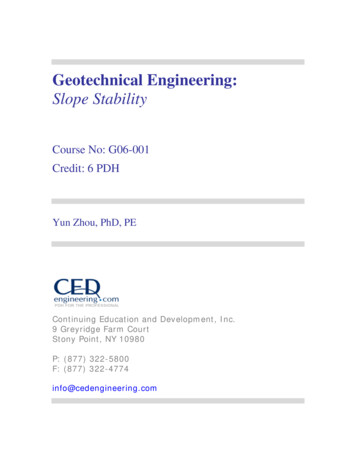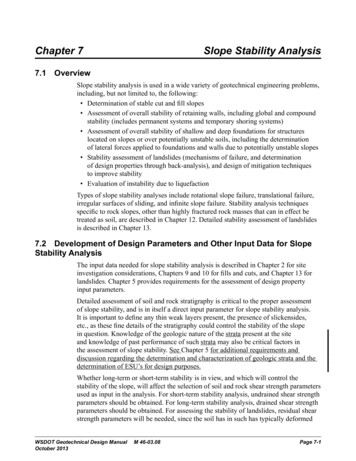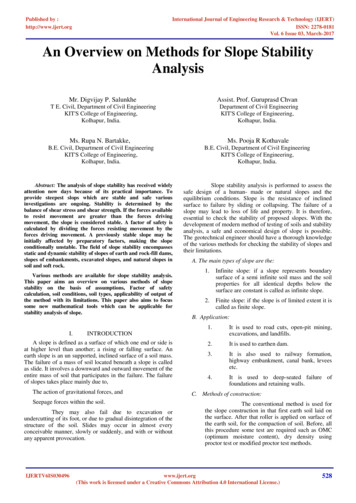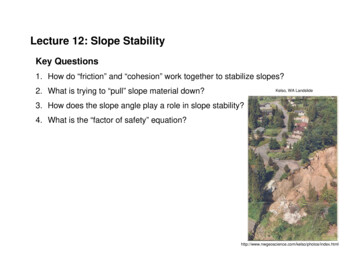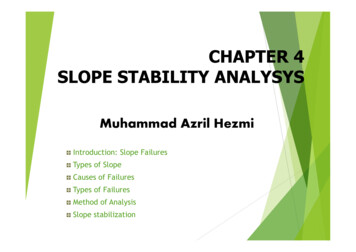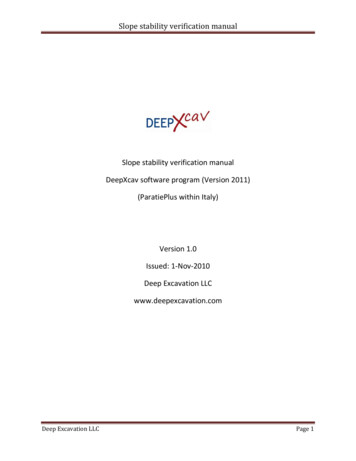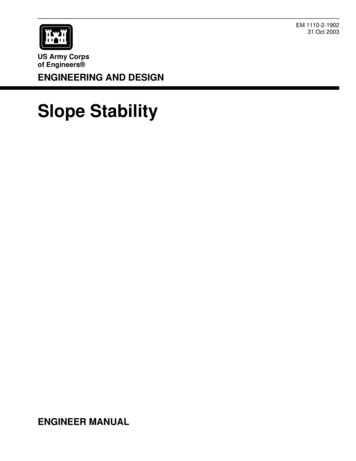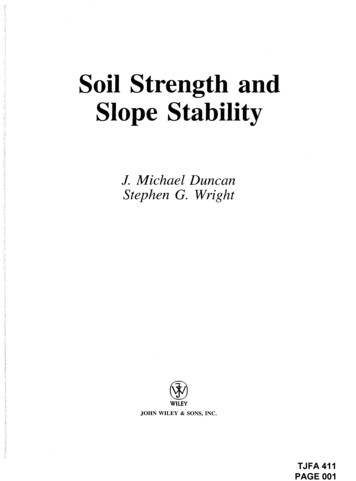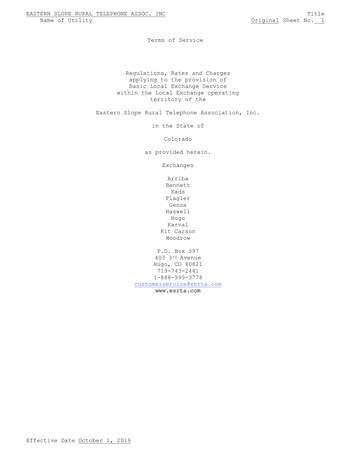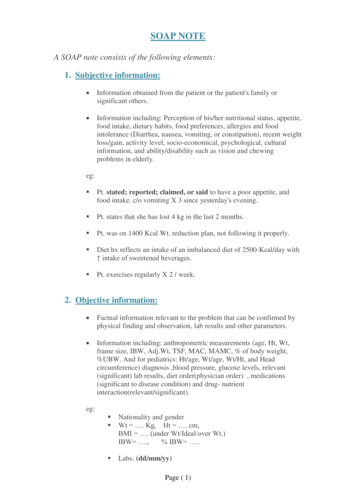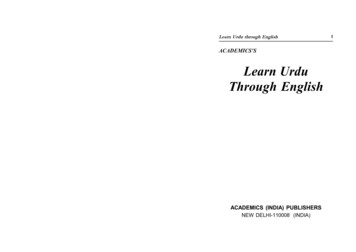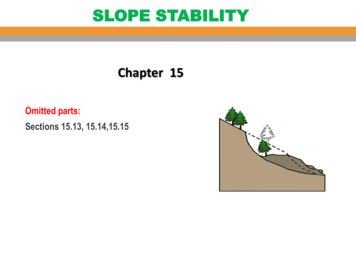
Transcription
SLOPE STABILITYChapter 15Omitted parts:Sections 15.13, 15.14,15.15
TOPICS Introduction Types of slope movements Concepts of Slope Stability Analysis Factor of Safety Stability of Infinite Slopes Stability of Finite Slopes with Plane Failure Surfaceo Culmann’s Method Stability of Finite Slopes with Circular Failure Surfaceo Mass Methodo Method of Slices
TOPICS Introduction Types of slope movements Concepts of Slope Stability Analysis Factor of Safety Stability of Infinite Slopes Stability of Finite Slopes with Plane Failure Surfaceo Culmann’s Method Stability of Finite Slopes with Circular Failure Surfaceo Mass Methodo Method of Slices
SLOPE STABILITYWhat is a Slope?An exposed ground surface that stands at an angle with the horizontal.Why do we need slope stability?In geotechnical engineering, the topic stability of slopes deals with:1. The engineering design of slopes of man-made slopes in advance(a) Earth dams and embankments,(b) Excavated slopes,(c) Deep-seated failure of foundations and retaining walls.2. The study of the stability of existing or natural slopes of earthworks andnatural slopes.o In any case the ground not being level results in gravity components of theweight tending to move the soil from the high point to a lower level. Whenthe component of gravity is large enough, slope failure can occur, i.e. the soilmass slide downward.o The stability of any soil slope depends on the shear strength of the soiltypically expressed by friction angle (f) and cohesion (c).
TYPES OF SLOPESlopes can be categorized into two groups:A. Natural slope Hill sides Mountains River banksB. Man-made slope Fill (Embankment)Earth damsCanal banksExcavation sidesTrenchesHighway Embankments
Case histories of slope failure Some of these failure can cause dramatic impact on livesand environment.Slope failures cost billions of every year in some countries
Case histories of slope failureBolivia, 4 March 2003, 14 people killed, 400 houses buriedSlope failures cost billions of every year in some countries
Case histories of slope failureBrazil, January 2003, 8 people killed
Case histories of slope failureLaConchita California Slump
Case histories of slope failure
Case histories of slope failure
Case histories of slope failureSlides: Rotational (slump)
Case histories of slope failure
TOPICS Introduction Types of slope movements Concepts of Slope Stability Analysis Factor of Safety Stability of Infinite Slopes Stability of Finite Slopes with Plane Failure Surfaceo Culmann’s Method Stability of Finite Slopes with Circular Failure Surfaceo Mass Methodo Method of Slices
Types of Slope Movementso Slope instability (movement) can be classified into sixdifferent types: FallsTopplesSlidesFlowsCreepLateral spreadsComplex
Falls Rapidly moving mass of material (rock or soil) that travels mostly through theair with little or no interaction between moving unit and another. As they fall, the mass will roll and bounce into the air with great force and thusshatter the material into smaller fragments. It typically occurs for rock faces and usually does not provide warning. Analysis of this type of failure is very complex and rarely done.
Falls Gravitational effect and shear strengthGravity has two components of forces:Tdriving forces: T W. sin bN resisting forces (because of friction)BoulderN W. cos bNSTf frictionthe interface develop itsresistance from friction (f):S N tan fIn terms of stresses:S/A N/A tan fbA effective Base Area of sliding blockortf s tan f
Falls
TopplesThis is a forward rotation of soil and/or rock mass about an axisbelow the center of gravity of mass being displaced.
Slideso Movements occur along planar failure surfaces that may run more-or lessparallel to the slope. Movement is controlled by discontinuities or weakbedded planes.Back-ScrapASlidesA. Translational (planar)Bulging atToeWeak beddingplaneOccur when soil of significantlydifferent strength is presented(Planar)
SlidesB. Rotational (curved)This is the downward movement of a soil mass occurring on analmost circular surface of rupture.BBack-ScrapBulgingCurved escarpmentC. Compound (curved)(Slumps)
Slides
SlidesReinforcementSoil nails
SlidesReinforcementAnchors شدادات Possible failuresurface
Flowso The materials moves like aviscous fluid. The failure planehere does not have a specificshape.It can take place in soil withhigh water content or in drysoils. However, this type offailure is common in the QUICKCLAYS, like in Norway.
Flows
Creep It is the very slow movement of slope material that occur over along period of time It is identified by bent post or trees.
Lateral spreadso Lateral spreads usually occur on very gentle slopes or essentially flat terrain,especially where a stronger upper layer of rock or soil undergoes extensionand moves above an underlying softer, weaker layer.weaker layer
Complex1. Falls2. Topples3. SlidesComplex movement is by a combination ofone or more of the other principal types ofmovement. A. Translational (planar) B. Rotational (slumps)4. Flow5. Creep6. Lateral Spread7. ComplexMany slope movements are complex,although one type of movementgenerally dominates over the others atcertain areas or at a particular time.
Types of Slope FailuresIn general, there are six types of slope failures:1. Falls2. Topples3. Slides4.5.6.7. Translational (planar) Rotational (curved)FlowsCreepLateral spreadsComplexSlide is the mostcommon mode ofslope failure, and it willbe our main focus inthis course
Types of Slide Failure Surfaces Failure of slopes generally occur along surfaces known as failure surfaces.The main types of surfaces are: Planar Surfaces: Occurs in frictional,non cohesive soils Rotational surfaces: Occurs in cohesive soilsCircular surface(homogeneous soil)Non-circular surface(non-homogeneous soil)
Types of Slide Failure Surfaces Compound Slip Surfaces:When there is hard stratum at some depth that intersectswith the failure plane Transitional Slip Surfaces:When there is a hard stratum at arelatively shallow depth
Types of Failure SurfacesFailure surfaceInfiniteLong planefailure surfaceTranslational(planar)2SlidesFinitePlane failuresurfaceAbove the toeRotational(curved)1FiniteThrough the toeDeep seated3
Types of Failure SurfacesTypes of Failure Surfaces Considered in this Course are1Stability of infinite slopes2Stability of finite slopes with planefailure surfaces3Stability of finite slopes with circularfailure surfaces
TOPICS Introduction Types of slope movements Concepts of Slope Stability Analysis Factor of Safety Stability of Infinite Slopes Stability of Finite Slopes with Plane Failure Surfaceo Culmann’s Method Stability of Finite Slopes with Circular Failure Surfaceo Mass Methodo Method of Slices
Concepts of Slope Stability AnalysisIn general we need to check The stability of a given existed slope Determine the inclination angle for a slope that we want tobuild with a given height The height for a slope that we want to build with a giveninclination
Methodology of Slope Stability AnalysisIt is a method to expresses the relationship between resisting forces anddriving forces Driving forces – forces which move earth materials downslope. Downslopecomponent of weight of material including vegetation, fill material, orbuildings. Resisting forces – forces which oppose movement. Resisting forces includestrength of material Failure occurs when the driving forces (component of thegravity) overcomes the resistance derived from the shearstrength of soil along the potential failure surface.
Methodology of Slope Stability AnalysisThe analysis involves determining and comparing the shear stress developedalong the most likely rupture surface to the shear strength of soil.
Slope Stability Analysis Procedure1. Assume a probable failure surface.2. Calculate the factor of safety by determining and comparingthe shear stress developed along the most likely rupturesurface to the shear strength of soil.3. Repeat steps 1 and 2 to determine the most likely failuresurface. The most likely failure surface is the critical surfacethat has a minimum factor of safety.4. Based on the minimum FS, determine whether the slope issafe or not.
Methods of Slope Stability Analysiso Limit equilibrium methodo Limit analysis methodo Numerical methodsWe will consider only the limit equilibrium method, since it isthe oldest and the mostly used method in practice.
Assumptions of Stability Analysiso The problem is considered in two-dimensionso The failure mass moves as a rigid bodyo The shear strength along the failure surface is isotropico The factor of safety is defined in terms of the average shearstress and average shear strength along the failure surface
TOPICS Introduction Types of slope movements Concepts of Slope Stability Analysis Factor of Safety Stability of Infinite Slopes Stability of Finite Slopes with Plane Failure Surfaceo Culmann’s Method Stability of Finite Slopes with Circular Failure Surfaceo Mass Methodo Method of Slices42
Factor of SafetyFactor of safety Resisting ForceDriving Force Shear StrengthShear StresstFs t fdtf Avg. Shear strength of soiltd Avg. Shear stress developed along the failure surface43
Factor of Safety The most common analytical methods of slope stability use afactor of safety FS with respect to the limit equilibrium condition,Fs is the ratio of resisting forces to the driving forces, orShear strength (resisting movement)average shear strength of the soil.Shear stress (driving movement)average shear stressdeveloped along the potentialfailure surface.FS 1 unstableFS 1 marginalFS 1 stable(Available)(developed)Generally, FS 1.5 is acceptablefor the design of a stable slopeIf factor safety Fs equal to or less than 1, the slope isconsidered in a state of impending failure44
Causes of slope failure1. External causesThese which produce increase of shear stress, like steepeningor heightening of a slope, building on the top of the slope2. Internal causesThese which cause failure without any change in externalconditions, like increase in pore water pressure.Therefore, slopes fail due either to increase in stress orreduction in strength.45
Factor of SafetyOther aspects of factor of safetyWhere:c’ cohesionf’ angle of internal frictioncd , fd cohesion and angle offriction that develop alongthe potential failure surfaceFactor of safety with respect to cohesionFactor of safety with respect to frictionWhen the factor of safety with respect to cohesion is equal to thefactor of safety with respect to friction, it gives the factor of safetywith respect to strength, orWhen Fc Ff thenFs Fc Ff 46
TOPICS Introduction Types of slope movements Concepts of Slope Stability Analysis Factor of Safety Stability of Infinite Slopes Stability of Finite Slopes with Plane Failure Surfaceo Culmann’s Method Stability of Finite Slopes with Circular Failure Surfaceo Mass Methodo Method of Slices47
Stability of Infinite SlopesWhat is an Infinite slope? Slope that extends for a relatively long distance and hasconsistent subsurface profile can be considered as infinite slope. Failure plane parallel to slope surface. Depth of the failure surface is small compared to the height ofthe slope. For the analysis, forces acting on a single slice of the sliding massalong the failure surface is considered and end effects isneglected.48
Infinite slope – no seepageo we will evaluate the factor of safety against a possible slope failurealong a plane AB located at a depth H below the ground surface.o Let us consider a slope element abcd that has a unit lengthperpendicular to the plane of the section shown.o The forces, F, that act on the faces ab and cd are equal and opposite andmay be ignored.The shear stress at the base of the slope element can be given byForce parallel to the plane ABTa W sin b g LH sin b(*)The resistive shear stress is given by49
Infinite slope – no seepageThe effective normal stress at the base of the slope element is given by(**)Equating R.H.S. of Eqs. (*) and (**) gives(***)For Granular Soil (i.e., c 0)tan f Fs tan bThis means that in case of infinite slope in sand, the value of Fs isindependent of the height H and the slope is stable as long as b f’50
Case of Granular soil – Derivation From Simple StaticsLExtraEquilibrium of forces on a slice:LFS Resisting ForcesDriving Forces51
Infinite slope – no seepageCritical Depth, HcrThe depth of plane along which critical equilibrium occurs isobtained by substituting Fs 1 and H Hcr into Eq. (***)52
Infinite slope – with steady state seepageSeepage is assumed to be parallel to the slopeand that the ground water level coincides withthe ground surface.The shear stress at the base ofthe slope element can be given(*)The resistive shear stress developed atthe base of the element is given by(**)53
Infinite slope – with steady state seepageEquating the right-hand sides of Eq. (*) and Eq. (**) yields(***)Recall(****)Substituting Eq. (****) Into Eq. (***) and solving for Fs givesc tan f Fs 2g H cos b tan b tan bNo seepage54
EXAMPLE55
EXAMPLE56
EXAMPLE57
Stability of Infinite Slopes Cohesive SoilsWith seepagetanf 'tanf ' d FsFs Hcr No seepagec'c ' d Fsg ' tanf 'g H cos2 b tan b g sat tan bsatc' c'cos 2 b (gsattan b g ' tan f ')tan f 'c'tan f ' c ' dd FFssc'tan f 'Fs gH cos 2 b tan b tan bHcr c'1g cos2 b (tan b tanf ')d58
Stability of Infinite SlopesGranular SoilsWith seepageNo seepagec' 0.0g ' tanf 'g H cos2 b tan b g sat tan bsatg ' tanf 'Fs gtan bc'Fs satIndependant of H c' 0.0Fs Fs c'tan f ' gH cos 2 b tan b tan btan f 'tan bSlope is stable as long as b f59
TOPICS Introduction Types of slope movements Concepts of S
Slope Stability Analysis Procedure. Methods of Slope Stability Analysis o Limit equilibrium method o Limit analysis method o Numerical methods We will consider only the limit equilibrium method, since it is the oldest and the mostly used method in practice. Assumptions of Stability Analysis o The problem is considered in two-dimensions o The failure mass moves as a rigid body o The shear .
